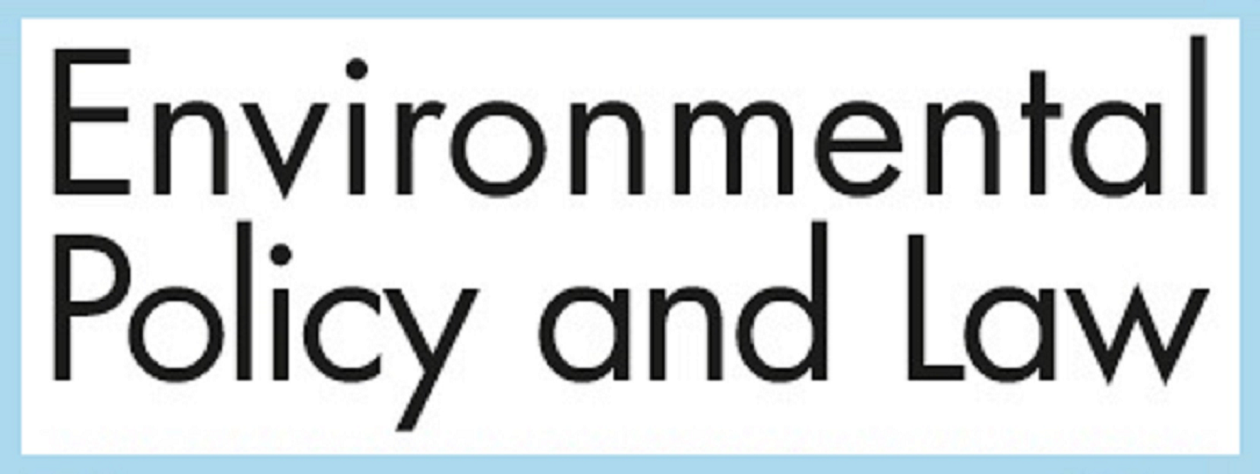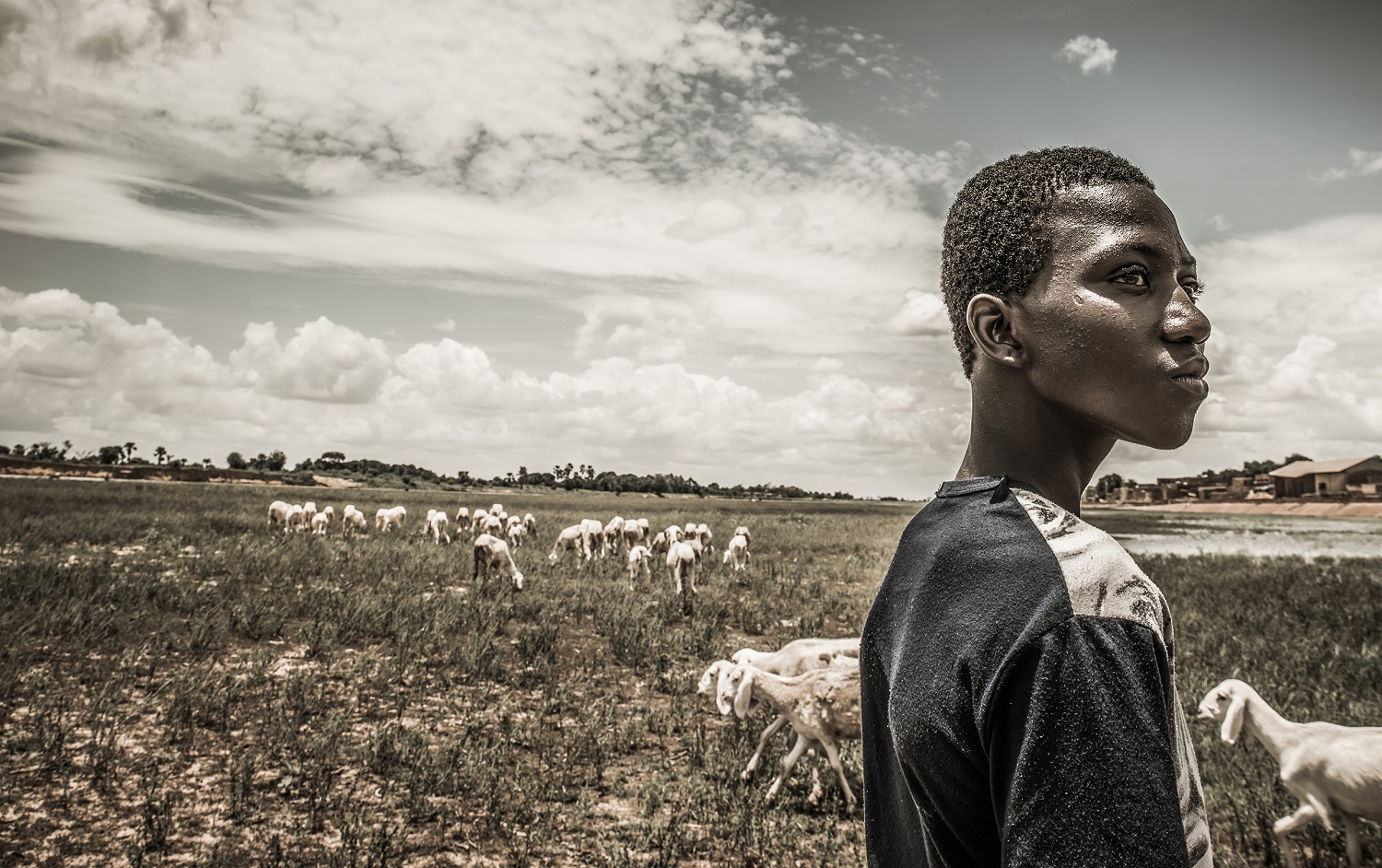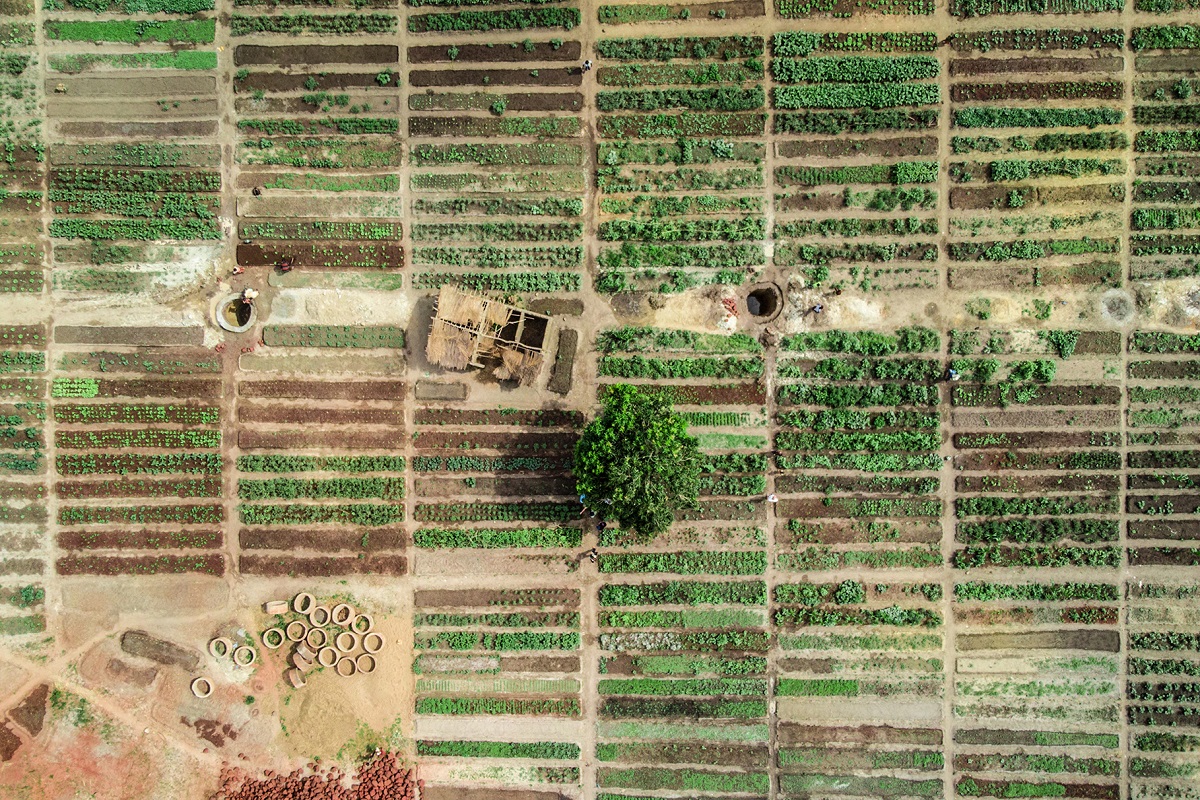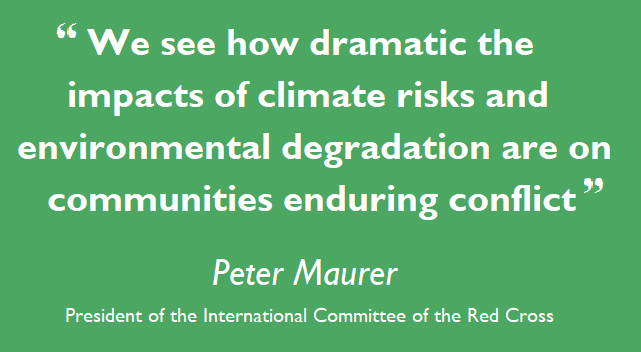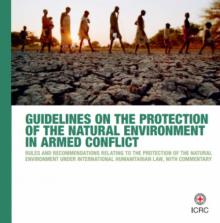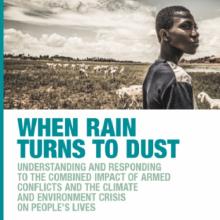
[Author: Peter Maurer, International Committee of the Red Cross]
Geneva, Switzerland – In this opinion piece, President of the International Committee of the Red Cross (ICRC) Peter Maurer takes stock of environmental degradation and damage in contemporary conflicts and sets out how parties to armed conflict and the humanitarian sector can tackle the challenge of the environment and climate crisis. Detailing the ICRC’s recently released Guidelines on the Protection of the Natural Environment in Armed Conflict, he emphasizes the need to accelerate implementation of the legal regime protecting the environment to safeguard communities enduring conflict – and future generations – from immediate and long-term impacts.
Reflections on the protection of the environment in war are often begun with recollections of historical events seared into our collective memory. The use of herbicides during the Vietnam War; the burning of oil wells during the 1990–1991 Gulf War; deforestation exacerbated by years of conflict in the Democratic Republic of the Congo. In this piece, I would like to set out how the environment continues to be damaged by conflicts in the 21st century, but also emphasize that we must shift our mindsets to act on the reality that – while not a single “event” in time – the climate crisis now defines how conflict-affected communities experience their natural environment. As I met with communities in the Sahel in 2020 [1], it was clear that impacts of conflict-related environmental damage are now compounded by the rapidly intensifying climate crisis.
We all have our part to play as we face this existential threat. Parties to armed conflict can integrate legal protections for the environment into their armed forces’ doctrine to reduce damage as they fight. Humanitarians in turn must commit sufficient resources and expertise to respond to the needs of those coping with the environmental consequences of conflict, and limit their own climate and environmental footprint.
To urge forward these actions, in 2020 the ICRC released two complementary publications. Our Guidelines on the Protection of the Natural Environment in Armed Conflict aim to contribute in a practical way to promoting respect for and protection of this precious asset even, or indeed especially, during armed conflict [2]. We also published a policy report, When Rain Turns to Dust, which explores the grave humanitarian consequences that arise when the climate crisis, environmental degradation, and armed conflict converge [3]. Drawing from these publications, this article sets out the nature of the environmental damage the ICRC observes, recommends how parties to armed conflict can reduce the damage they cause, and concludes with reflections for humanitarian actors.
Environmental Damage and Climate Crisis in Armed Conflicts
Armed conflicts have direct and indirect impacts on the natural environment, and climate risks now magnify this harm for dependent communities. Too often, the natural environment is directly attacked or suffers incidental damage as a result of the use of certain methods or means of warfare. It is also at risk from damage and destruction to the built environment – including industrial complexes, combustible storage and processing facilities, factories and plants, agricultural facilities, and waste sites – across urban and rural areas. Environmental consequences are manifold: Attacks contaminate water, soil and land and release pollutants into the air; explosive remnants of war cause further contamination; and biodiversity is irreparably degraded as warfare is waged in hotspots. Indeed, over 80% of all major armed conflicts between 1950 and 2000 took place directly in biodiversity hotspots that sustain around half the world’s plants and many rare species of animals [4].
The indirect effects of conflict are just as bad. The deterioration of governance and infrastructure service systems cause further environmental degradation, as can population displacement. Illicit exploitation of natural resources to sustain war economies, or for personal gain, contributes to lasting environmental damage while perpetuating violence [5]. In fact, according to a 2009 report by the United Nations Environment Programme, at least 40 per cent of internal armed conflicts in the last 60 years have been related to natural resources [6]. A concurrent reduction in institutional capacity for environmental management further compounds harm and hinders recovery long after a conflict has ended. The effect of environmental damage on communities is complex in many ways, but in one sense it is quite simple: The effect is total. Damage to their environment impacts food and water security, health, and livelihoods of conflict-affected communities.
At the same time, countries experiencing conflict are on the front line of climate change: 12 of the 20 countries which, according to the ND-GAIN Country Index, are the most vulnerable and least ready to adapt to climate change are also sites of armed conflict. This statistic manifests in the reality observed by ICRC operations on a daily basis: In Iraq and Yemen for example, we see water scarcity threaten public health and jeopardize food and economic security. In 2020, my visits to the Sahel were shaped by accounts of floods not seen in 50 years that were contributing to the displacement caused by armed violence; more than one million people were forced to flee their homes in Mali, Niger, and Burkina Faso over the past year. At the same time, desertification is advancing such that land is increasingly difficult to cultivate. The fact that these can occur concurrently – extreme weather events, environmental degradation, and armed conflict – has an immediacy that I encounter more and more as I travel to countries where the ICRC has priority operations.
I want to be clear. The reason why these issues matter to the ICRC is not because climate change is directly causing conflict. The relationship is indirect and complex. The reason why these issues matter to us is because we see how dramatic the impacts of climate risks and environmental degradation are on communities enduring conflict. This forces us to think hard about how to adapt our response, and how the parties to armed conflict with whom we engage can change their behavior to mitigate environmental harm.
Our Call to States and Parties to Armed Conflict
Faced with these realities, the ICRC is accelerating our outreach to States to boost the implementation of obligations to protect the natural environment under international humanitarian law (IHL), sometimes referred to as the modern law of armed conflict. To assist States and other actors who may be called on to interpret and apply these obligations, we have updated our Guidelines on the Protection of the Natural Environment in Armed Conflict [7].
These Guidelines set out 32 rules and recommendations relating to the protection of the natural environment under IHL. A concise commentary accompanies each rule or recommendation to aid understanding and to clarify its source and applicability. The rules include protections provided to all parts of the natural environment as civilian objects by the IHL principles of distinction, proportionality, and precautions; protections provided by rules on specially protected objects such as objects indispensable to the civilian population; protections provided by rules governing enemy property; and rules governing the use of specific weapons [8].
The Guidelines are intended to facilitate the adoption of concrete measures by States and armed groups, and can be incorporated into military manuals and national policy and legal frameworks. The adoption of such measures at the national level is essential to ensure that the protections enshrined in law are put into practice. It is now up to governments and other actors of influence to take action accordingly.
Of course, not all environmental damage in conflict is addressed by IHL, and the “role” of the Guidelines is one piece of a larger whole. There is certainly much environmental damage in armed conflict that IHL does not address: That caused by human displacement, the carbon footprint of war, or the exploitation of natural resources driven by wartime economies, for example. The climate crisis, similarly, does not have a simple relationship with war: For example, sometimes deforestation has been reported to slow in times of conflict. So while respecting IHL can support environmental protection efforts in the armed conflict, it is not sufficient in and of itself, and we are careful to situate the Guidelines as one relevant contribution among many other necessary efforts being led by the United Nations Environment Programme, the International Law Commission, and many others.
With this context in mind, better respect for IHL will nevertheless limit the impact of armed conflict on the natural environment and the deeply interlinked consequences for conflict-affected populations who depend on it. The ICRC proposes the following four key recommendations to policy makers, military practitioners, and others in positions to influence the behavior of warring parties:
- First, disseminate IHL rules protecting the natural environment as reflected in the updated Guidelines more comprehensively in national policy and legal frameworks.
- Second, adopt measures to increase understanding of the effects of conflict on the natural environment to minimize the impact of military operations, for instance by mapping areas of environmental importance or fragility prior to the conduct of military operations.
- Third, consider identifying and designating areas of particular environmental importance or fragility, such as national parks, natural reserves and endangered species habitats, as demilitarized zones.
- Finally, exchange examples and good practices of measures that can be taken to comply with IHL obligations protecting the natural environment, through activities such as conferences, military training and exercises, and regional forums.
To date, States and National Red Cross and Red Crescent Societies have submitted a variety of pledges of this kind to improve the protection of the natural environment in armed conflict [9], and we hope to see much more progress in coming years.
Our Call to the Humanitarian Sector and Beyond
Humanitarian organizations also have a role to play, by helping to build strong and resilient communities that can withstand environmental degradation and successive climate shocks. We already work at the levels of systems, communities, and individuals: From building walls which protect communities from floods, to supporting new micro-economic enterprises, introducing waste management systems and practices, to vaccinating livestock and distributing drought-resistant seeds. But we collectively need to do more, with adequate resources, expertise and leadership, to strengthen our support along five lines of action:
- First, we must skill up to respond adequately to the vulnerabilities and needs resulting from the intersection of conflict and climate risks.
- We must team up across the International Red Cross and Red Crescent Movement, the humanitarian sector and beyond to strengthen climate action during armed conflict and to ensure that people already suffering the consequences of war are not left out. The challenges we face are enormous, existential. Cooperation, more than ever, is critical.
- We must anticipate risks and strengthen resilience, in order to protect communities by promoting respect for the environment during armed conflict and by designing programs that help people develop resilient livelihoods and shelters, reinforce access to hazard-resilient essential services, and ensure that populations are adequately informed of risks and adaptation pathways.
- We must mobilize for improved climate action and finance so that climate action reaches places in crisis and funding is more equitably balanced between mitigation and adaptation efforts.
- And we must lead by example, by limiting the damage we cause to the environment and the climate and by ensuring the resilience of our operations to extreme weather events.
The Challenge Ahead
Perhaps the biggest challenge ahead is the shift in mindset and mechanics needed in the institutions of States, humanitarian actors, and those engaged in hostilities – from one of business-as-usual to one of urgency. The importance of protecting the environment in armed conflict has historically dipped in and out of humanitarian and public preoccupation. It has taken images of black-smoke filled skies from blazing oil to capture our attention. Now, as the depth of our dependence on the environment for our survival is increasingly understood, its protection in armed conflict can no longer be an afterthought.
References
1. ICRC (2020), “A conflict without borders continues to play out in the Sahel” (08 July 2020). Link: https://www.icrc.org/en/document/conflict-without-borders-continues-play-out-sahel (last accessed: 12 February 2021).
2. ICRC (2020), Guidelines on the Protection of the Natural Environment: Rules and recommendations relating to the protection of the natural environment under international humanitarian law with commentary (ICRC, Geneva). Available at: https://www.icrc.org/en/document/guidelines-protection-natural-environment-armed-conflict-rules-and-recommendations-relating (last accessed: 12 February 2021).
3. ICRC (2020), When Rain Turns to Dust: Understanding and Responding to the Combined Impact of Armed conflicts and the Climate and Environment Crisis on People’s Lives (ICRC, Geneva). Available at: https://shop.icrc.org/when-rain-turns-to-dust-pdf-en (last accessed: 12 February 2021).
4. T. Hanson et al. (2009), “Warfare in biodiversity hotspots”, Conservation Biology, 23(3): 578–587.
5. C. Bruch, C. Muffett and S.S. Nichols (Eds) (2016), Governance, Natural Resources, and Post-Conflict Peacebuilding (Routledge, Abingdon). Also see: UNEP (2019), Environmental Rule of Law: First Global Report (UNEP, Nairobi), 19 and 231–232.
6. See UNEP (2009), From conflict to peacebuilding: The role of natural resources and the environment (UNEP, Nairobi), 5.
7. The 2020 ICRC Guidelines are the updated iteration of their 1994 predecessor. Supported by a resolution of the United Nations (UN) General Assembly, the ICRC drew up the 1994 guidelines and submitted them to the UN as a contribution to the Decade of International Law. The General Assembly subsequently invited all States to give due consideration to the possibility of incorporating them into their military manuals and other instructions addressed to their military personnel.
8. For the complete list of the 32 rules and recommendations, see pp. 7–11: ICRC (2020), Guidelines on the Protection of the Natural Environment: Rules and recommendations relating to the protection of the natural environment under international humanitarian law with commentary (ICRC, Geneva). Available at: https://www.icrc.org/en/document/guidelines-protection-natural-environment-armed-conflict-rules-and-recommendations-relating (last accessed: 12 February 2021).
9. See, for instance, the pledges submitted at the 33rd International Conference of the Red Cross and Red Crescent, Geneva, 2019, jointly by the Governments and National Red Cross Societies of Denmark, Finland, Iceland, Norway and Sweden; by the Government of Finland and the Finnish Red Cross; and by the Government of Burkina Faso. Available at: https://rcrcconference.org/about/pledges/search (last accessed: 12 February 2021).
